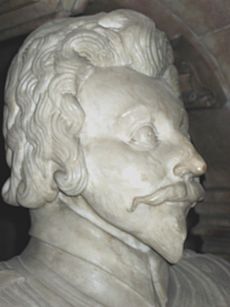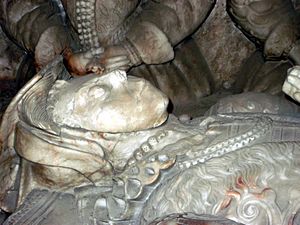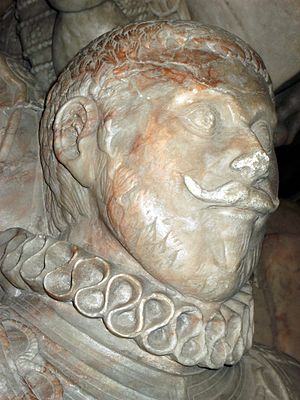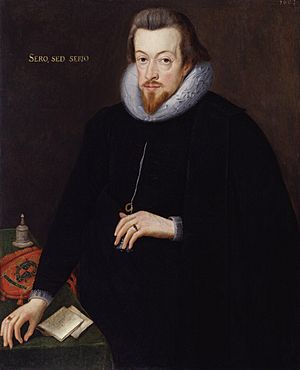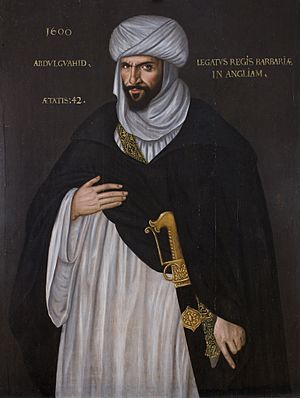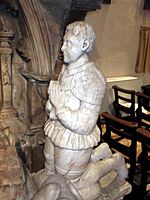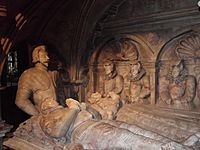Thomas Gerard, 1st Baron Gerard facts for kids
Thomas Gerard, 1st Baron Gerard (born around 1564 – died 15 January 1618) was an important landowner and politician in Staffordshire and Lancashire, England. He was a member of the English Parliament six times, representing three different areas. During the time of Queen Elizabeth I, he was a key supporter of the Earl of Essex. However, he managed to stay out of the Essex Rebellion. Later, when King James I came to power, Thomas Gerard received even greater honors, including becoming a Baron.
Contents
Who Was Thomas Gerard?
Thomas Gerard's parents were both important people. His father was Sir Gilbert Gerard. He was a brilliant lawyer from Ince, Lancashire, and Gerrard's Bromley, Staffordshire. Gilbert became the Attorney General when Queen Elizabeth I first became queen. He held this job for over 22 years! Later, he became the Master of the Rolls, another very high legal position. He played a big part in setting up the Elizabethan Religious Settlement, which was how the Church of England was organized.
Thomas's mother was Anne Ratcliffe. She was the daughter of Thomas Ratcliffe from Winmarleigh, Lancashire. Anne was an heiress, meaning she inherited a lot of money and land. This brought great wealth to her marriage with Gilbert Gerard. Anne remained a Catholic throughout her life, which was common for many wealthy families in Lancashire at the time.
Thomas Gerard was taught at home by a tutor named Thomas Taylor. It is believed he grew up in the south of England. When he joined Caius College, Cambridge, in 1580, at age 16, he was described as being from Harrow on the Hill. He became a member of the House of Commons of England when he was only 20 years old, representing Lancaster.
Starting His Political Career
Thomas Gerard's early steps in politics were thanks to his father's influence. His father, Gilbert Gerard, had been made a special officer called "vice-chancellor" in Lancaster in 1571. The Duchy of Lancaster was a powerful land area connected to the Crown. It always had a big say in who became a Member of Parliament (MP) for the town. Usually, the candidates were friends of the Duchy's officials.
In 1584, the people of Lancaster simply sent a blank election form to Gilbert Gerard. He was the Duchy's chief legal officer. He then filled in his son Thomas's name. Thomas was elected alongside Henry Sadler, whose father was also a high-ranking official. Both Thomas Gerard and Henry Sadler were elected again for Lancaster in 1586.
In 1588, Thomas Gerard was chosen to represent both Lancashire and Staffordshire in Parliament. His family owned land in both areas. By this time, he had also married Alice Rivet, who had land in Staffordshire. So, he chose to represent Staffordshire. It's likely that Robert Devereux, 2nd Earl of Essex, a powerful figure in the county, influenced this choice. Because Gerard chose Staffordshire, Lancashire had to hold another election in 1589.
Joining the Essex Group
In 1591, the Earl of Essex led an English army to help Henry IV of France in a war. Essex convinced both Gerard and another MP, Walter Harcourt, to join this journey. After a successful campaign, Essex made both of them knights outside the city of Rouen. They both seemed to become strong supporters of Essex.
Essex saw Staffordshire as his own county and wanted to build his power there. He had a castle there and his mother lived nearby. He gathered a group of ambitious, mostly young, landowners to support him. Essex was generally tolerant of different religious beliefs. This might have appealed to Gerard, whose own father was sometimes accused of being a Protestant in London and a Catholic in Lancashire.
In 1593, Gerard was very helpful to Essex. Essex wanted his stepfather, Christopher Blount, and Gerard to be elected as MPs for Staffordshire. However, another person, Walter Harcourt, also wanted to be elected. Essex didn't clear up the confusion, so his supporters in Staffordshire were unsure what to do. Luckily, Gerard still had influence in Lancashire and was able to get elected for that county instead.
The election in Lancashire was not easy. There was a lot of disagreement between two powerful families. However, Gerard was elected along with his brother-in-law, Richard Molyneux. Soon after, Thomas's father, Gilbert Gerard, died. This meant Thomas inherited his father's large estates and properties. After this, Gerard was able to build good relationships with the important families in the Merseyside area.
New Opportunities and Challenges
Thomas Gerard's loyal service to Essex brought him many opportunities, especially in military projects. In 1595, he was made captain of the Isle of Man. He was told to quietly improve the island's defenses without upsetting the local government.
Perhaps feeling a bit unsure about Essex's leadership, Gerard sent a gift of a trained sparrowhawk to Robert Cecil. Cecil was the Secretary of State and Essex's main rival for the Queen's attention. Gerard sent a note with the bird to make sure Cecil knew it was a friendly gesture.
Soon, Gerard was busy gathering weapons and ammunition. He worked with William Stanley, the Earl of Derby, to make sure payments were made correctly.
In March 1596, Essex asked Gerard to recruit a thousand men for a joint English and Dutch expedition to Cadiz in Spain. Gerard went with the expedition as a colonel. The Capture of Cadiz was a huge defeat for Spain, with the city and Spanish fleet destroyed. Gerard wasn't paid for his service, but he had his own small ship that he used for privateering (attacking enemy ships for profit). Over the next two years, he helped organize local defense forces in several counties to protect against a possible Spanish invasion. In May 1597, Gerard was given the important job of Knight Marshal of the Household, working directly under Essex.
In November 1597, Gerard was again elected to Parliament for Lancashire.
Moving Away from Essex
The war in Ireland eventually caused Gerard to separate from the Essex group. Essex was made the Lord Lieutenant of Ireland, a job many expected him to fail at. Gerard traveled with Essex to Ireland in April 1599. They stayed together at Gerard's home in Gerrard's Bromley on the way. They arrived in Dublin on April 15, but Gerard left just five days later. It's not clear what his role was, but he did not return to Essex in Ireland. Gerard was ordered to send supplies to Ireland from the Isle of Man, but he had no further direct contact with Essex there. By April 1600, Gerard was back in London, doing duties like escorting the French ambassador and staying in close contact with Robert Cecil.
When Essex returned to England in disgrace in May, Gerard left the court and went to the countryside. It seems he had been accused of something related to his dealings with Essex. Gerard wrote to Robert Cecil on May 9, trying to explain his actions and clear his name. He was clearly worried.
Gerard managed to distance himself enough from Essex to get back to his duties within a few months. In July, he asked Cecil to make sure the soldiers on the Isle of Man were paid in cash, not goods, to help the local economy.
In August 1600, Gerard was living in his house in Charing Cross and again performing diplomatic duties. This time, he was responsible for the travel and food arrangements for the "Barbery Embassador" (the Moroccan Ambassador), Abd el-Ouahed ben Messaoud. This was a very important and sensitive task given to him by Cecil. England was trying to strengthen its friendship with Morocco, as the Sultan of Morocco was an ally against Spain and a big trading partner. Gerard arranged for the ambassador to stay in a house in London. He rode to Gravesend to meet the Moroccan group and made sure they were comfortable before riding back to London to ensure everything was ready for them.
When the Essex Rebellion happened in February 1601, Gerard was one of the first to speak out against it. He was the one who handed over Essex and his main supporters to the Tower of London on February 9. In April, Gerard and Molyneux were suspected of being involved with two Catholic priests who were executed, but they were cleared by the priests' own statements.
Gerard was appointed the chief legal officer for Staffordshire in 1601. In October of that year, he was easily re-elected to Parliament for Staffordshire. He was elected alongside Sir John Egerton, a relative of the Lord Chancellor.
Under King James I
When King James I became king in 1603, Thomas Gerard was immediately welcomed into the new king's favor. He was made a peer, becoming Baron Gerard of Gerards Bromley. He was one of only 13 peers allowed into the king's private rooms. The king even visited Gerard's large house at Gerrard's Bromley. Another frequent visitor was Robert Cecil, with whom Gerard continued their shared interest in falconry (hunting with trained birds).
In 1616, Gerard was appointed president of the Council of Wales and the Marches. This council was based in Ludlow and oversaw the government in Wales and several English counties. He also became Lord Lieutenant of Wales, a position linked to the council's presidency. However, it seems this job was mostly honorary. He stayed in London and did not actively use his power in the field, resigning in 1617.
Thomas Gerard suspected his life was coming to an end and made his will on October 6, 1617. He owned a vast amount of land and possessions. He left large amounts of money to his younger sons, William and John. His second wife was also well provided for. He made smaller but still significant gifts, including £50 for his servant Edward Lloyd. He asked to be buried at night, without a big funeral, in the church at Ashley, Staffordshire, near his home. His father had also been buried there. He died on January 15, 1618, and was buried as he wished. A life-sized statue of him kneeling was placed behind his parents' tomb in the church.
Family Life
Thomas Gerard was married twice.
- His first wife was Alice, the daughter of Sir Thomas Rivet. They had three sons:
- Gilbert, who inherited his father's title and became the 2nd Baron Gerard (died 1622). He married Eleanor Dutton. They had four children who survived:
- Dutton (1613-1640), who became the 3rd Baron Gerard. He married Lady Mary Fane and later Lady Elisabeth O'Brien.
- Alice, who married Roger Owen.
- Frances (died 1636), who married Robert Needham, 3rd Viscount Kilmorey.
- Elizabeth (died 1679), who married Sir Peter Leycester, 1st Baronet .
- William.
- John.
- Gilbert, who inherited his father's title and became the 2nd Baron Gerard (died 1622). He married Eleanor Dutton. They had four children who survived:
- His second wife was Elizabeth, the daughter of Robert Woodford. They did not have any children together. After Gerard's death, Elizabeth married Patrick Ruthven. They had three sons and a daughter named Mary Ruthven (died 1645). Mary was a maid of honor to Queen Henrietta Maria and married the famous painter Anthony van Dyck. Their daughter, Justiniana van Dyck, was born on the day the painter died.


